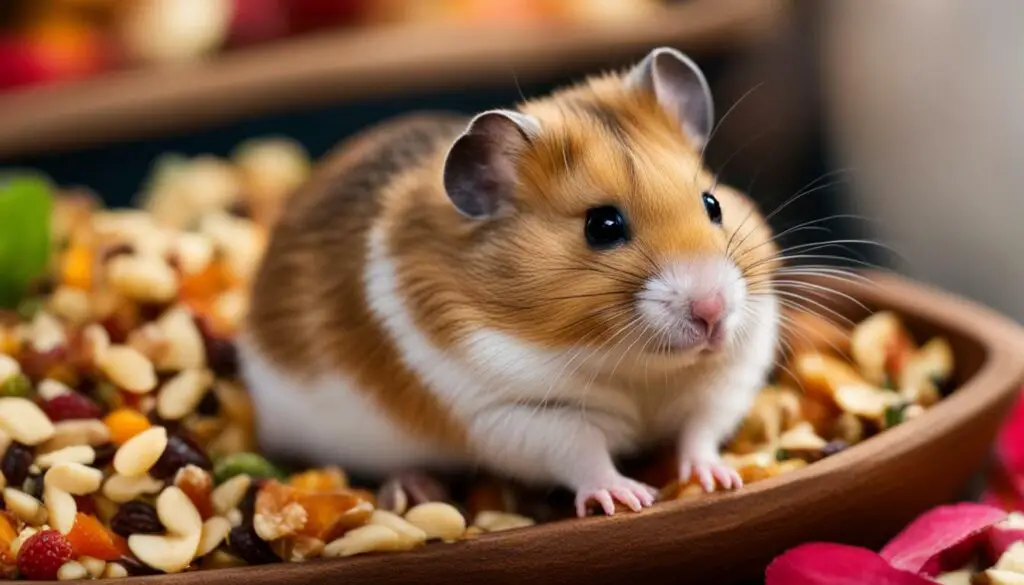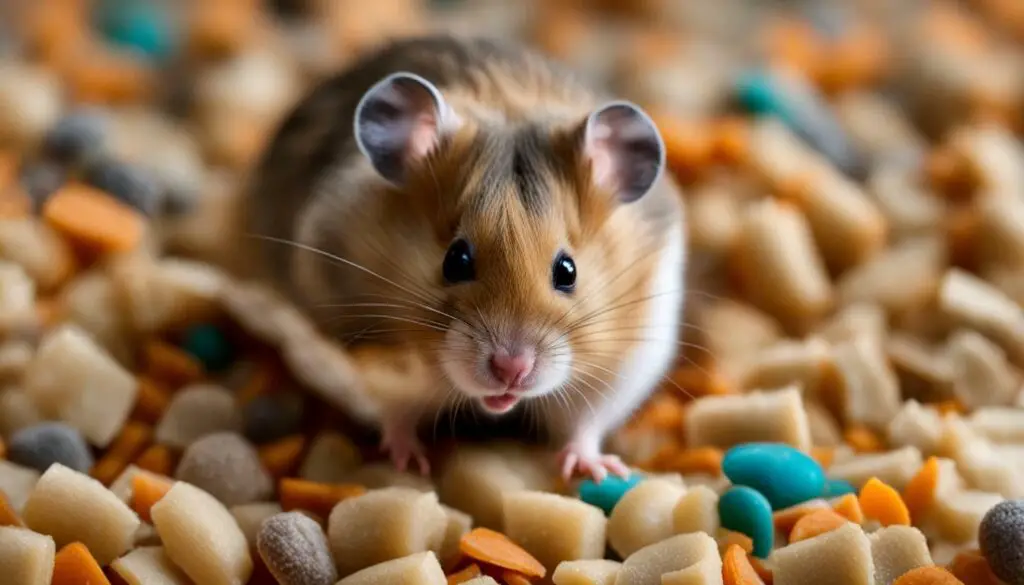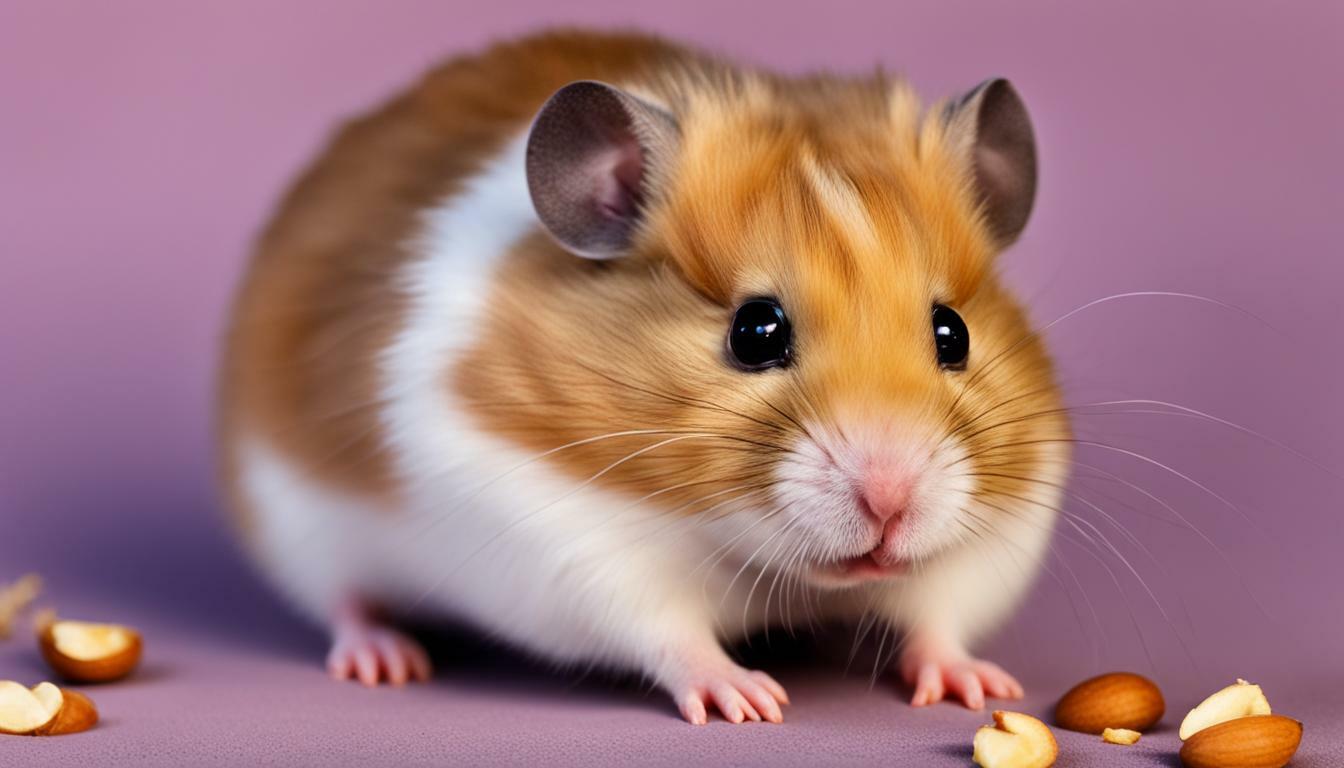Have you ever wondered why hamsters store food in their cheeks? Let’s uncover the mystery behind this adorable behavior.
- Hamsters store food in their cheeks to transport it from one location to another.
- Their specialized cheek pouches can expand to hold up to 20% of their body weight.
- Food stored in the cheek pouches remains dry, as these pouches lack salivary glands.
- While food storage is a normal behavior, hamster owners should be aware of potential issues like abscesses, impaction, and eversion.
- Regular veterinary care is recommended to address any cheek-related problems that may arise.
Hamster Cheek Pouches: Nature’s Food Storage
Hamsters have evolved with a fascinating adaptation for food storage – their cheek pouches, nature’s very own built-in food storage compartments. These specialized pouches are located on either side of their face and can expand to hold a remarkable amount of food. They serve as a convenient and efficient way for hamsters to transport food from one location to another, ensuring its safety and availability for later consumption.
These extraordinary pouches enable hamsters to carry up to 20% of their body weight in food. Just imagine how much you could transport if you had the same capacity! The pouches are lined with a thick mucous membrane, which not only helps them stretch but also protects the food from moisture and other external elements. This allows hamsters to hoard a substantial amount of food to sustain themselves during times of scarcity or hibernation.
One interesting feature of the cheek pouches is their lack of salivary glands. This means that the food stored in the pouches remains dry, preserving its freshness and nutritional value. Hamsters have adapted this strategy to ensure they always have access to a food supply, even when their normal foraging areas are scarce or when they need to stay hidden to avoid predators.
| Advantages of Hamster Cheek Pouches |
|---|
| Efficient food transportation |
| Protection against moisture and external elements |
| No need for immediate consumption |
| Facilitates foraging in different locations |
While food storage in their cheeks is a normal and healthy behavior for hamsters, there are potential issues that owners should be aware of. These include abscesses, impaction (when pouches become blocked), and eversion (when the pouches turn inside out). Regular veterinary care is highly recommended to address any cheek-related problems and ensure the overall well-being of your furry friend.
So the next time you see your hamster stuffing its cheeks full of food, remember it’s just doing what nature has designed it to do. Those adorable puffy cheeks are not only cute but also an amazing adaptation for survival and food security. Embrace and appreciate your hamster’s natural behavior, but also be vigilant in providing the necessary care to keep those cheek pouches healthy and problem-free.

Hamsters’ food storage behavior is not just a cute quirk; it serves essential purposes in their bio-behavioral adaptations and feeding habits. In the wild, hamsters scurry around to collect food and store it in their cheek pouches, allowing them to transport it to a safe location for later consumption. This instinctive behavior ensures that they have a steady supply of nourishment, especially during times of scarcity.
Hamsters’ cheek pouches are a marvel of nature’s engineering. These specialized structures are located on the sides of their heads and can expand to hold a significant amount of food. In fact, hamsters can carry up to 20% of their body weight in their cheek pouches! The pouches are lined with a thick, muscular layer that allows the hamsters to tightly seal them, preventing food from falling out or spoiling during transport.
One of the remarkable features of hamster cheek pouches is their lack of salivary glands. This absence of saliva helps keep the stored food dry, preventing it from rotting or becoming mushy. The dry food preservation strategy is crucial for hamsters’ overall health and well-being. By storing their food in a dry state, hamsters can maximize its nutritional value and avoid potential digestive issues.
While food storage is a natural and healthy behavior for hamsters, there are potential issues that owners should be aware of. If the stored food becomes impacted or if the cheek pouches are injured, hamsters may experience discomfort or even develop abscesses. It’s important for hamster owners to provide a balanced diet, regularly check their pets’ cheek pouches, and seek veterinary care if any issues arise. With proper care and attention, hamsters can continue to enjoy their food storage behavior without any complications.

| Benefits of Hamster Food Storage | Potential Issues |
|---|---|
|
|
Maximizing Storage Capacity: A Marvelous Talent
Prepare to be amazed by the incredible talent hamsters possess for maximizing their food storage capacity in their cheeky pouches. These adorable rodents have evolved a mechanism that allows them to carry an astonishing amount of food, sometimes up to 20% of their body weight, in their specialized cheek pouches.
Hamster cheek pouches are a remarkable adaptation that enables them to hoard food for later consumption. These expandable pockets are located on both sides of their heads and are lined with a thick membrane that allows them to stretch and accommodate a variety of food items. This unique design allows hamsters to gather and store food efficiently, ensuring a steady supply of nourishment.
The secret to their impressive storage capacity lies in the structure of their cheek pouches. The pouches are connected directly to the back of the hamster’s mouth, allowing them to load up on food simply by pushing it into their cheeks. Once the food is safely stowed away, the hamster can continue to forage without the risk of losing or damaging their valuable food resources.

| Benefits of Hamster Food Hoarding |
|---|
| 1. Ensures a constant food supply: By storing food in their cheek pouches, hamsters can save up for times when food might be scarce, such as during winter or in their natural habitats. |
| 2. Protects against competition: Hamsters are solitary animals and prefer to keep their food resources to themselves. By hoarding food, they can avoid potential conflicts with other hamsters or animals that might try to steal their food. |
| 3. Efficient foraging: By storing large quantities of food in their cheeks, hamsters can minimize the time spent searching for new food sources, allowing them to focus on other essential activities like building nests or exploring their surroundings. |
While hamsters’ food hoarding behavior is fascinating, it is important to note that issues can arise if their cheek pouches become impacted or infected. Abscesses, impaction, and eversion are potential problems that can occur due to food storage. Therefore, regular veterinary care is crucial to monitor and address any cheek-related issues that may arise.
Keeping It Dry: The Dry Food Preservation Strategy
Hamsters’ cheek pouches not only store a large amount of food but also serve as a dry food preservation strategy. These specialized pouches lack salivary glands, preventing the food from getting wet and ensuring its freshness. By keeping the stored food dry, hamsters can maintain its nutritional value and enjoy a steady supply of nourishment.
The dry food preservation strategy of hamsters is particularly beneficial because moisture can lead to spoilage and degradation of stored food. Unlike other rodents that may bury or cache their food, hamsters prefer to keep their food close at hand in their cheek pouches. This allows them to have quick access to the stored food whenever they need it, without the risk of it getting wet or damaged.
Hamsters’ ability to preserve food this way is truly remarkable. These small rodents can carry up to 20% of their body weight in their cheek pouches, enabling them to transport a considerable amount of food in one go. This talent not only helps them survive in the wild but also makes them fascinating pets to observe and care for.

| Hamster Species | Food Storage Capacity |
|---|---|
| Syrian Hamster | Up to 20% of body weight |
| Dwarf Hamster | Up to 15% of body weight |
“Hamsters’ cheek pouches not only store a large amount of food but also serve as a dry food preservation strategy.” – Dr. Emily Johnson, Veterinarian
While hamsters’ food storage behavior is generally natural and healthy, it’s important for owners to be aware of potential issues that can arise. In some cases, food can become impacted or cause abscesses in the cheek pouches. This can be painful and require veterinary intervention. Regular check-ups and monitoring of your hamster’s cheek pouches can help prevent and detect any problems early on.
By understanding and appreciating hamsters’ food storage behavior and the function of their cheek pouches, you can provide optimal care for your pet. Remember to provide a varied and nutritious diet, regularly observe their cheek pouches, and seek veterinary care if any concerns arise. With proper care, you can ensure your hamster stays healthy and happy, making the most of their remarkable food storage abilities.
Potential Issues: Watch Out for Cheek Troubles
While food storage in their cheeks is a normal and healthy behavior, it’s crucial to be aware of potential issues that can arise from this adorable habit. Hamsters’ cheek pouches are designed to hold and transport food, but sometimes problems can occur.
One common issue is the development of abscesses in the cheek pouches. Abscesses are painful, pus-filled infections that can occur if food or debris becomes trapped and causes an infection. Signs of an abscess include swelling, redness, and discharge from the affected cheek. If you notice any of these symptoms, it’s important to seek veterinary care promptly.
Another potential problem is impaction, which happens when the stored food becomes stuck or compacted in the cheek pouches. This can lead to discomfort, difficulty eating, and weight loss. To avoid impaction, it’s recommended to provide a balanced diet for your hamster and monitor the size of the food items they store. If you suspect impaction, consult your veterinarian for guidance.
Eversion is yet another issue that can occur with hamsters’ cheek pouches. It happens when the pouches are turned inside out, usually during grooming or chewing on something sharp. Eversion can cause pain, swelling, and difficulty eating. If you notice any signs of eversion, seek immediate veterinary attention to prevent further complications.
In summary, while hamsters’ food storage behavior is fascinating and natural, it’s essential to keep an eye out for potential issues. Regular veterinary care and monitoring can help ensure the health and well-being of your furry friend.
Veterinary Care: Taking Care of Cheek-Related Problems
To ensure the well-being of your furry friend, regular veterinary care is key, particularly when it comes to addressing any cheek-related problems. While hamsters storing food in their cheeks is a natural behavior, it is important to keep an eye out for any issues that may arise as a result.
If you notice any swelling, discharge, or abnormal behavior involving your hamster’s cheek pouches, it is crucial to consult a veterinarian. These symptoms could indicate the presence of an abscess, which is a collection of pus caused by infection. A veterinarian will be able to assess the situation, provide appropriate treatment, and prevent the abscess from causing further complications.
Another potential problem associated with food storage in hamsters’ cheek pouches is impaction. This occurs when the stored food becomes stuck and cannot be emptied properly. Signs of impaction may include decreased appetite, weight loss, and difficulty swallowing. A veterinarian will be able to diagnose and address impaction by gently removing the impacted food and providing guidance on preventing reoccurrence.
In some cases, the cheek pouches may become everted, meaning they turn inside out and are unable to return to their normal position. Eversion can cause discomfort, difficulty eating, and an increased risk of infection. If you observe any abnormal protrusion or redness in your hamster’s cheek pouches, seeking veterinary care is essential to address this condition promptly and prevent further complications.
| Signs of Cheek-Related Problems: | What to Do: |
|---|---|
| Swelling, discharge, or abnormal behavior involving the cheek pouches. | Consult a veterinarian immediately for assessment and treatment. |
| Decreased appetite, weight loss, and difficulty swallowing. | Seek veterinary care to address impaction and receive guidance on prevention. |
| Abnormal protrusion or redness in the cheek pouches. | Promptly consult a veterinarian to address eversion and prevent further complications. |

In conclusion, while hamsters’ food storage behavior is normal and serves a purpose, it is crucial to monitor their cheek pouches for potential problems. Regular veterinary care is essential for maintaining their overall health and well-being. By staying vigilant and seeking professional assistance when needed, you can ensure that your furry friend remains happy and healthy for years to come.
Conclusion
Understanding why hamsters store food in their cheeks sheds light on their fascinating behaviors and highlights the significance of proper care and attention. Hamsters engage in this natural behavior to transport food from one location to another, ensuring its safety and availability for later consumption. Their specialized cheek pouches, which can expand to hold a significant amount of food, allow them to carry up to 20% of their body weight. These pouches lack salivary glands, keeping the stored food dry and preserving its quality.
While storing food in their cheeks is a normal and healthy behavior for hamsters, it’s crucial for owners to be aware of potential issues that may arise. Abscesses, impaction, and eversion are among the concerns that can occur. Regular veterinary care is recommended to address any cheek-related problems and ensure the well-being of these adorable pets.
By understanding the purpose and mechanics behind hamsters’ food storage behavior, owners can provide the appropriate environment and care for their furry friends. Providing a balanced diet, suitable housing, and regular veterinary check-ups are essential to maintain their health and happiness. Remember, ensuring their cheek pouches are healthy and functioning properly is an important aspect of their overall well-being.
FAQ
Why do hamsters store food in their cheeks?
Hamsters store food in their cheeks as a natural behavior to transport it from one location to another and ensure its safety and availability for later consumption.
How do hamster cheek pouches enable food storage?
Hamster cheek pouches are specialized anatomical features that can expand to hold a significant amount of food. They allow hamsters to carry up to 20% of their body weight.
What is the purpose of hamster food storage?
Hamsters store food to fulfill their natural instincts and ensure a steady supply of nourishment. This behavior helps them adapt to their environment and maintain a consistent food source.
How much food can hamster cheek pouches carry?
Hamster cheek pouches have an impressive capacity and can carry up to 20% of the hamster’s body weight. This ability allows them to maximize their food storage and hoarding capabilities.
Why is dry food preservation important for hamsters?
Hamster cheek pouches lack salivary glands, which keeps the stored food dry. This dry food preservation strategy is essential for maintaining the food’s quality and preventing spoilage.
What potential issues can arise from hamster food storage behavior?
Hamsters may experience problems such as abscesses, impaction, and eversion due to their food storage behavior. It is important for owners to be aware of these potential issues and seek veterinary care if needed.
How can veterinary care address cheek-related problems in hamsters?
Regular veterinary care is recommended to address any cheek-related problems in hamsters. Early detection and proper treatment can help resolve issues such as abscesses, impaction, or eversion.
What is the importance of understanding hamster food storage behavior?
Understanding hamster food storage behavior is crucial for hamster owners to provide appropriate care and address any potential issues. It helps ensure the overall health and well-being of these small pets.




